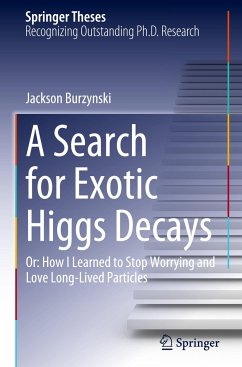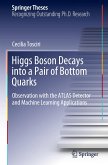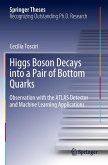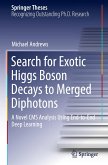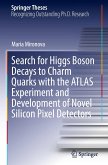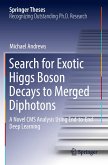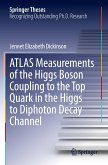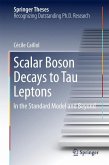The absence of new physics at the TeV scale observed thus far at the Large Hadron Collider (LHC) motivates an increasing focus on searches for weakly-coupled new particles and exotic signatures. In particular, particles with macroscopic mean proper lifetimes, known as long-lived particles (LLPs), are of significant interest due to their ability to elude the majority of searches which rely on the assumption that Beyond Standard Model particles decay close to the primary interaction point. Many models which aim to solve various issues with the Standard Model (SM) introduce new particles with lifetimes that are either unconstrained, or even shown to prefer the macroscopic regime. These theories often point to the Higgs boson as a possible portal to new physics, with exotic Higgs decays being the primary phenomenological consequence and means of discovery. It is well motivated both from theory and experimental constraints to consider the scenario in which the particles produced in these exotic decays have macroscopic proper lifetimes and give rise to unique detector signatures.
This work describes a search for exotic decays of the Higgs boson to two long-lived, neutral, spin-0 particles which subsequently decay to pairs of b quarks, giving the striking signature of displaced hadronic jets in the ATLAS inner detector. Several other ATLAS searches have probed this decay topology previously, excluding branching ratios of the Higgs boson to LLPs of more than 10% for proper lifetimes greater than 100mm. These searches relied on dedicated triggers designed to select events with LLPs decaying in the ATLAS calorimeter or muon spectrometer. The lack of an equivalent trigger for LLP decays in the ATLAS inner detector has been a limiting factor in probing LLP lifetimes less than 100mm. To circumvent the difficulty of triggering on LLP decays, the search presented in this thesis exploits the ZH associated production mode, relying on leptonic trigger signatures to select interesting events. This is the first search for Higgs boson decays into LLPs to exploit this analysis methodology and additionally makes use of several novel methods for both background rejection and background estimation.
No excess over Standard Model predictions is observed, and upper limits are set on the branching ratio of the Higgs boson to LLPs . Depending on the mass of the LLP, branching ratios greater than 10% are excluded for lifetimes as small as 4mm and as large as 100mm, probing an important gap in the ATLAS exotic Higgs decay programme. In comparison to the previous searches for Higgs decays to LLPs, these are among the most stringent limits placed on this scenario, and for LLPs with masses below 40 GeV these results represent the strongest existing constraints on the branching ratio of the Higgs boson to LLPs in this lifetime regime.
This work describes a search for exotic decays of the Higgs boson to two long-lived, neutral, spin-0 particles which subsequently decay to pairs of b quarks, giving the striking signature of displaced hadronic jets in the ATLAS inner detector. Several other ATLAS searches have probed this decay topology previously, excluding branching ratios of the Higgs boson to LLPs of more than 10% for proper lifetimes greater than 100mm. These searches relied on dedicated triggers designed to select events with LLPs decaying in the ATLAS calorimeter or muon spectrometer. The lack of an equivalent trigger for LLP decays in the ATLAS inner detector has been a limiting factor in probing LLP lifetimes less than 100mm. To circumvent the difficulty of triggering on LLP decays, the search presented in this thesis exploits the ZH associated production mode, relying on leptonic trigger signatures to select interesting events. This is the first search for Higgs boson decays into LLPs to exploit this analysis methodology and additionally makes use of several novel methods for both background rejection and background estimation.
No excess over Standard Model predictions is observed, and upper limits are set on the branching ratio of the Higgs boson to LLPs . Depending on the mass of the LLP, branching ratios greater than 10% are excluded for lifetimes as small as 4mm and as large as 100mm, probing an important gap in the ATLAS exotic Higgs decay programme. In comparison to the previous searches for Higgs decays to LLPs, these are among the most stringent limits placed on this scenario, and for LLPs with masses below 40 GeV these results represent the strongest existing constraints on the branching ratio of the Higgs boson to LLPs in this lifetime regime.

